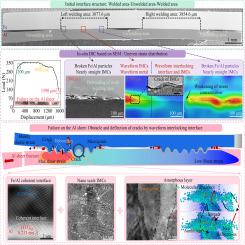冲击焊接接头拉伸变形行为的现场分析
IF 9.4
1区 工程技术
Q1 ENGINEERING, MECHANICAL
International Journal of Mechanical Sciences
Pub Date : 2025-09-22
DOI:10.1016/j.ijmecsci.2025.110858
引用次数: 0
摘要
磁脉冲焊接作为一种固态冲击焊接技术,已广泛应用于飞机飞控管、核燃料棒端壳、汽车传动轴等领域。然而,目前的报道主要集中在优化制造工艺以获得优越的关节力学性能,而忽略了其在应力作用下的动态响应。本研究首次揭示了持续载荷下Al/Fe磁脉冲焊接接头焊接区特征和多尺度界面微观结构的协同变形效应。现场数字图像相关和光滑颗粒流体动力学模拟的创新结合证实了焊接区域的异步变形行为和显著的应变局部化。现场观察表明,波形型金属间化合物层通过吸收变形能,增加裂纹扩展路径,延缓了弱结合区裂纹扩展。最后,界面裂纹受到波形联锁界面的阻碍而偏转到铝板上。漩涡区Al-Fe相干界面、中间口袋中的纳米级金属间化合物和非晶层的结合,使得波形联锁界面具有优异的焊接强度。此外,分子动力学模拟结果表明,源自Fe原子的位错扩展到非晶层中,从而促进了先前存在的位错向Al原子发射,有效地降低了界面处的快速应力集中。这些发现填补了目前磁脉冲焊接接头力学性能研究的空白,为优化接头界面微观结构提供了有价值的见解。本文章由计算机程序翻译,如有差异,请以英文原文为准。

In-situ analysis on tensile deformation behavior of impact welding joint
As a solid-state impact welding technique, magnetic pulse welding has previously been applied in aircraft flight control tubes, end enclosures for nuclear fuel rods, automotive transmission shafts, etc. However, current reports focus on optimizing the manufacturing process to achieve superior mechanical properties of the joints, neglecting their dynamic response under stress. This study provides the first insights into the synergistic deformation effects of the welding zone characteristics and multiscale interface microstructure of an Al/Fe magnetic pulse welded joint under sustained loading. An innovative combination of in-situ Digital image correlation and Smooth particle hydrodynamics simulation confirms the asynchronous deformation behavior and significant strain localization in the welded zones. In-situ observations show that the waveform intermetallic compounds layer causes delay in the crack propagation originating from the weakly bonded zone by absorbing deformation energy and increasing the crack propagation path. Finally, interface cracks are hindered by the waveform interlocking interface and are deflected into the Al sheet. The combined presence of Al-Fe coherent interfaces within vortex zones, nanoscale intermetallic compounds in intermediate pockets, and amorphous layers contributes to the excellent welding strength of the waveform-interlocking interface. In addition, molecular dynamics simulation results demonstrate that dislocations originating from Fe atoms propagate into the amorphous layer, thus promoting the emission of pre-existing dislocations into Al atoms and effectively reducing the rapid stress concentration at the interface. These findings fill a gap in current research on the mechanical properties of magnetic pulse welded joints and provide valuable insights for optimizing the joint interface microstructure.
求助全文
通过发布文献求助,成功后即可免费获取论文全文。
去求助
来源期刊

International Journal of Mechanical Sciences
工程技术-工程:机械
CiteScore
12.80
自引率
17.80%
发文量
769
审稿时长
19 days
期刊介绍:
The International Journal of Mechanical Sciences (IJMS) serves as a global platform for the publication and dissemination of original research that contributes to a deeper scientific understanding of the fundamental disciplines within mechanical, civil, and material engineering.
The primary focus of IJMS is to showcase innovative and ground-breaking work that utilizes analytical and computational modeling techniques, such as Finite Element Method (FEM), Boundary Element Method (BEM), and mesh-free methods, among others. These modeling methods are applied to diverse fields including rigid-body mechanics (e.g., dynamics, vibration, stability), structural mechanics, metal forming, advanced materials (e.g., metals, composites, cellular, smart) behavior and applications, impact mechanics, strain localization, and other nonlinear effects (e.g., large deflections, plasticity, fracture).
Additionally, IJMS covers the realms of fluid mechanics (both external and internal flows), tribology, thermodynamics, and materials processing. These subjects collectively form the core of the journal's content.
In summary, IJMS provides a prestigious platform for researchers to present their original contributions, shedding light on analytical and computational modeling methods in various areas of mechanical engineering, as well as exploring the behavior and application of advanced materials, fluid mechanics, thermodynamics, and materials processing.
 求助内容:
求助内容: 应助结果提醒方式:
应助结果提醒方式:


